Boulle in the Royal Collection
André-Charles Boulle's furniture had elaborate inlays and was much copied

André-Charles Boulle (1642–1732) was furniture-maker, gilder and sculptor to Louis XIV of France (1638–1715). His outstanding ability to inlay furniture with pictorial marquetry in wood, and later elaborate tortoiseshell and brass or pewter inlays, gave the technique its name: Boulle or Buhl work. Fashionable in his own time, Boulle's creations were also heavily imitated during the eighteenth and nineteenth centuries. This later interest in Boulle work resulted in exact copies of seventeenth-century furniture as well as adaptations of the technique to contemporary designs.
Marquetry entails the use of small pieces of different materials (including exotic woods, tortoiseshell, pewter, brass, horn, mother-of-pearl, among other materials) to create elaborate designs on furniture. Boulle was so skilled at wood pictorial marquetry that he became known as a ‘painter in wood’, but it was his tortoiseshell and brass designs that established his reputation and made him a favourite among royalty and the aristocracy. Pewter or brass inlay on tortoiseshell was known as premier-partie, while tortoiseshell inlay on brass or pewter was contre-partie. For an even more sumptuous effect, mother-of-pearl, stained horn and dyed tortoiseshell would be included in the design.
The demand for Boulle furniture persisted throughout the eighteenth century and the advent of Neo-classicism, with its accompanying nostalgia for the style of Louis XIV, made Boulle furniture even more popular. The French ébéniste Étienne Levasseur (1721–98) made his career by creating pastiches of Boulle pieces, sometimes applying original marquetry panels to contemporary furniture forms. In the nineteenth century, English cabinet-makers like Thomas Parker (active 1808–30) began to employ this style, which became known as, ‘Buhl’.
Most of the furniture in the Royal Collection made by, or attributed to, Boulle was acquired by George IV (1762–1830). A Francophile, the king furnished the royal palaces with large quantities of fashionable French furniture from the 1780s until his death in 1830. The lavish style and use of exotic materials accorded well with his extravagant taste. However, due to the volume of eighteenth- and nineteenth-century imitations, as well as the fact that Boulle did not sign his work, it can be difficult to definitively credit pieces to the maker. For this reason, many of the Boulle-marquetry pieces in the Royal Collection are recorded as ‘attributed to André-Charles Boulle’.
Click on an object below to learn more about ‘Boulle’ objects in the collection.







